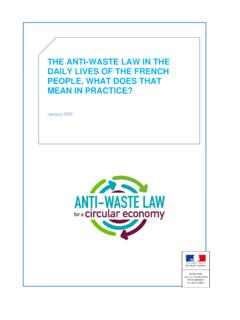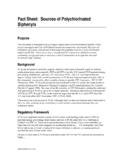Transcription of Plastic Recycling Fact Sheet - Europa
1 EuRIC AISBL Recycling : Bridging Circular Economy & Climate PolicyPlastic Recycling FactsheetIntroductionMoving towards a circular economy for plastics 2 How to further promote plastics Recycling in Europe European targets for Plastic waste Recycling How to further enhance plastics Recycling in Europe 18 to promote the shift towards a circular economy Plastics and its uses Commodity plastics Plastics for packaging Engineering plastics Plastics from construction and demolition Bio-plastics 11 Plastics Recycling Industry Current status and The plastics Recycling process Environmental benefits Economic importance International trade 1601020304 EuRIC AISBL Recycling : Bridging Circular Economy & Climate PolicyMain challenges to increase plastics Recycling capacity across Europe Need for recycled content targets to pull end-mar-kets for recycled plastics.
2 Lack of re--& Greenhouse Gas (GHG) emissions savings or job creation in Europe. Lack of to improve the overall waste management infrastructure. strict separate col-lection obligations to increase plastics quality. legislative frame-work to boost the implementation of targets for re-cycling and recycled content, to control and restrict illegal waste exports to countries lacking infra-structure for proper treatment and further contribute to products eco-design. Lack of interface between waste and chemicals legislation, with substances of concern gnisopa systemic problem to a proper assessment of safe plastics Recycling streams, taking into consideration actual risks based on suitable plastics demand in 20185 Annual global Plastic production has increased from 2 to 380 million tonnes since 1950 and is projected to double by 2035 and almost to quadruple by 20501,2.
3 In addition, global consumption of plastics has increased more than 20 times in the last 50 years, and it is esti-mated to double again by 2034 if action is not taken3. IntroductionMoving towards a circular economy for plastics01 EuRIC - Plastic Recycling Factsheet2 Despite Europe is one of the most advanced regions regarding plastics colle ction and Recycling , Recycling rate is still at 30%3. European countries lack the capacity to manage increasing amounts of Plastic waste in circular and sustai-nable plastics production4,5 million tonnes in 201760 million tonnes in million tonnes in 201839,9%19,8%9,9%6,2%4,1%3,4%16,7%Utmos t need to improve design for Recycling for all products made of or incorporating & Circular EconomyRESOURCE EXTRACTIONPRODUCTIONDISTRIBUTIONCONSUMPT IONWASTELINEAR ECONOMYPRODUCTIONDISTRIBUTIONCONSUMPTION RE-USE/REPAIR/RECYCLERECYCLING SECTORCIRCULAR ECONOMYEuRIC AISBL Recycling .
4 Bridging Circular Economy & Climate Policy3 EuRIC - Plastic Recycling FactsheetPlastics sector and the circular economy - Key benefits7 From the 30 million tonnes of Plastic colle cted in 2016 in Europe, million tonnes ( ) were recycled, while million tonnes ( ) were exported outside Eu-rope, million tonnes ( ) were used for energy recovery, and million tonnes ( ) were disposed represent a serious waste-handling problem with only 10% of the Plastic waste generated worldwide being recycled. The remainder follows a linear economy mod-el, involving disposal or Recycling ratesDecrease the use of natural resourcesReduce CO2 emissionsControlled exportsStable marketsPlastics Recycling is instrumental to close the loop of the circular economy by re-introducing into the economy high-quality Plastic recyclates incorporated into new products.
5 Not all the plastics are equally recycled. It will depend not only on its characteristics but also on the additives that are factors to further increase the amount of plastics that can be recycled. The most common commodity resins and recyclability challenges associated to them are8,9,10:EuRIC AISBL Recycling : Bridging Circular Economy & Climate PolicyPET/PETEV/PVCHDPEPOLYETHYLENE TEREPHTALATE (PET/PETE) PET is a dimensionally stable thermoplastic with excellent ma-chining characteristics. It is clear, tough and solvent resistant. Commonly present in: beverage bottles, microwavable trays, and PET items are highly recyclable, however, proper collection is instrumental to avoid cross-contamination from other materials HIGH-DENSITY POLYETHYLENE (HDPE) HDPE is a versatile, high-impact, lightweight thermoplastic with an excellent chemical resistance and high tensile strength.
6 Com-monly present in: milk and detergent bottles, Plastic bags, toys, pipes and furniture. Although HDPE is highly recyclable, only 10-15% is recycled in Eu-rope as, due to its softness, it needs to be sorted from harder fractions of plastics before CHLORIDE (V/PVC) High corrosion resistant Plastic , hard, rigid, can be clear, can be solvent welded. Commonly present in: blister pack/clamshell pack-and window frames. Easy to separate by conventional processes, however Recycling is limited due to the presence of some additives ( , chlorine, cad- mium, lead). Plastics and its uses Commodity plastics02 EuRIC - Plastic Recycling Factsheet4( , colorants).EuRIC AISBL Recycling : Bridging Circular Economy & Climate PolicyPS/EPSPPLDPELOW-DENSITY POLYETHYLENE (LDPE) resistance.
7 Commonly present in: squeezable bottles, shrink wrap, bread bags, frozen food bags, wire and cable applications. Generally recyclable however, due to its softness, it needs to be previously sorted from harder fractions of plastics and treated in adequate Recycling (PP) -sion, abrasion and impact resistance. Commonly present in: yogurt and margarine containers, bottle caps, ketchup bottles, food pack-aging, reusable containers and plant pots. PP items are highly recyclable, however Recycling is limited due to -terials ( , colorants).POLYSTYRENE (PS) AND EXPANDED POLYSTYRENE (EPS) While PS is clear, glassy, rigid, brittle, opaque and melts at 95 C, EPS is foamed, lightweight, energy absorbing and heat insulati ng.
8 Com-monly present in: meat/poultry trays, Plastic foam cups/plates, CD cases, Plastic cutlery, eyeglasses frames, video and CD cases, and egg boxes. -cess through conventional Recycling PLASTICS Other plastics such as bioplastics or plastics formed by a com-bination of resins or multi materials of unknown composition ( , oven baking bags, some reusable water bottles, plastics for automotive, aircraft, medical parts, etc.). Rarely recycled as they are not compatible with conventional Recycling processes due to the variability of its - Plastic Recycling FactsheetHEuRIC AISBL Recycling : Bridging Circular Economy & Climate PolicyBetween 2006 and 2018, the quantity of Plastic packaging waste has increased by 19% in Europe, from million tonnes to million tonnes5.
9 Ranging between 26-52%, more than half of the countries in Europe have Plastic packaging Recycling rates above 40%. Czechia, Spain and Netherlands are on the top of the list with rates close to 50% Plastics for packagingPlastics for packaging help to keep the content of the packaging safe and prevent it from contamina-tion, particularly when talking about food packaging. They are mainly consumed for: Recycling is the first option for packaging waste in Europe5 Since SAFETY AND TRANSPORTFOOD PACKAGINGEuRIC - Plastic Recycling Factsheet6 Plastics for packaging are the first most widely used Plastic ( ) in Europe5, and are also the most common Plastic waste that can be found in European of those items have been designed to be used only once - Single Use Plastics -Plastics for packaging is a priority area when it comes to design for recyclability.
10 Today they account for about 60% of post-consumer Plastic bottlesFood containersPlasticsbagsCurtlery & strawsCups & lidsCrisp packetsRecyclingRecycling of Plastic waste from packaging has increased by 92%.Energy recovery from Plastic packaging waste has increased by 84%.Landfilling of Plastic packaging waste has decreased by 54%.Energy AISBL Recycling : Bridging Circular Economy & Climate PolicyEngineering plastics are designed to provide better mechanical and thermal properties than the commodity plastics (presented before). They are mostly used for the automotive and by electrical and electronic equipment (EEE) of plastics in the automotive and EEE sector in the past few decades has increased sharply. Thanks to their improved properties, namely, abrasion resistance, chemical resistance, impact strength, electrical properties, and operating temperature amongst others, engineering plastics contribute significantly to innovation in the auto-motive and the EEE sectors.

